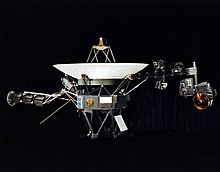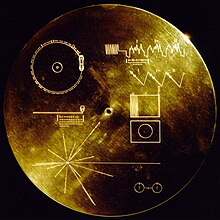Voyager program
The Voyager program is a NASA research program to explore the outer planetary system and interstellar space . It comprises the planning, construction and research mission of the two space probes Voyager 1 and Voyager 2 . These started in 1977 . The two missions continue to this day.
prehistory
The roots of the Voyager program go back to the mid-1960s. Michael Minovitch from the Jet Propulsion Laboratory (JPL) was the first to recognize the possibility of using the motion of Jupiter in its orbit to accelerate space probes (" swing-by "). Three years later, engineer Gary Flandro, also at JPL, calculated some trajectories for probes that were to take advantage of the favorable positions of the outer planets in the late 1970s. Jupiter should serve as a “stepping stone” to reach the planets Saturn , Uranus , Neptune and Pluto in an acceptable time (“ Planetary Grand Tour ”). Between 1976 and 1978 the following routes were possible: Jupiter – Saturn – Uranus – Neptune, Jupiter – Saturn – Pluto and Jupiter – Uranus – Neptune. NASA did not want to miss this opportunity , because such a favorable planetary constellation will only repeat itself 176 years later.
NASA's original plans included some very large probes to be launched using Saturn V launchers . At the end of the 1960s, efforts began to develop a family of probes for exploring the outer planets - the “Thermoelectric Outer Planets Spacecraft” (TOPS) project.
In 1969, NASA then presented the "Grand Tour Suite", which was merged into the "Outer Planets Grand Tour Project" (OPGTP), which provided for the use of four to five probes based on the TOPS concept. Two probes were to start on the Jupiter – Saturn – Pluto route in 1976 and 1977, and two more in 1979 on the Jupiter – Uranus – Neptune route. The program should cost about $ 700 million in total.

The OPGTP was canceled in the early 1970s as it was viewed as too expensive and too ambitious. Instead, it was finally decided to build Voyager 1 and 2, which was more of a stopgap solution. Compared to the TOPS program, the service life should be strictly limited to four instead of ten years. This measure should limit the total costs (construction and mission phase) to about 250 million US dollars. The designers secretly disregarded this instruction and adopted many of the safety systems and concepts that had already been developed from the TOPS drafts. The first funds flowed on July 1, 1972, and the program was officially launched. The concept phase was completed by March 1975.
Construction of the two Voyager probes began in mid-1975. The JPL tried again to get NASA to finance another probe, but it did not succeed. Important impulses for the construction flowed from the experiences of the Pioneer probes 10 and 11, which measured the type and intensity of the radiation at Jupiter and thus allowed a corresponding adjustment of the probes. Since the two probes were initially planned as an extension of the Mariner series, the program was initially called Mariner Jupiter-Saturn with the names "Mariner 11" and "Mariner 12" for the two probes. A new name was chosen due to the major structural differences to the Mariner probes. The name Voyager , found through a NASA competition, was officially confirmed on March 4, 1977.
Original mission objectives
The Voyager probes had no particular research focus, as there was little prior knowledge about the outer planets that could have been expanded. Therefore, the mission objectives are relatively broad:
- Investigation of the atmosphere of Jupiter and Saturn with regard to circulation, structure and composition
- Analysis of the geomorphology , geology and composition of the moons
- More precise determination of the mass, size and shape of all planets, moons and rings
- Investigation of various magnetic fields with regard to their field structure
- Analysis of the composition and distribution of charged particles and plasma
- Particularly detailed investigations of the moons Io and Titan
Scientific instruments: → see Voyager probes .
Voyager 1
Voyager 1 was launched on September 5, 1977 - 16 days after its sister probe Voyager 2 - from Launch Complex 41 on Cape Canaveral with a Titan IIIE Centaur rocket. After 18 months of flight, the probe reached Jupiter on March 5, 1979.
Voyager 1 took extensive measurements on Jupiter and Saturn and their moons, ring systems and atmospheres and sent numerous images to Earth. The knowledge of the two planets was significantly expanded by Voyager 1.
Voyager 1 reached Saturn in November 1980. With the swing-by maneuver around Saturn, the probe swiveled into its final orbit, on which it has since been flying at an angle of 35 ° to the ecliptic through the outer areas of the solar system to its limit . The last phase of the mission began on January 1, 1990: the “Voyager Interstellar Mission” (VIM).
In February 1998, Voyager 1 overtook the Pioneer 10 probe and has since been the most distant human-made object, as well as the one with the fastest escape speed from the solar system. , 2002, Voyager 1 in the outer region of Heliosphäre , the Helio shell (heliosheath) a, in which the solar wind and the interstellar medium mix. In spring 2010 there were indications that the probe was approaching the heliopause . Voyager 1 has been in interstellar space since August 2012 .
Voyager 2
Voyager 2 took off in front of its sister probe Voyager 1 on August 20, 1977 with a slightly different and slower trajectory.
On July 9, 1979, Voyager 2 passed after its sister probe Jupiter and examined the newly discovered rings and Jupiter's night side more closely. Nine months after Voyager 1, Voyager 2 reached Saturn in August 1981 . While Voyager 1 was already on the way to its interstellar mission, the first corrective maneuvers were carried out for Voyager 2 in the spring of 1981 in order to be able to bring the space probe to Uranus , which it reached on January 24, 1986. Through the Uranus passage, it was sent on to Neptune , where it flew by on August 25, 1989 and examined it for a total of five months. Nine previously unknown moons were discovered, but only Proteus could be examined more closely. Voyager 2 is the first and so far only spacecraft to visit Uranus and Neptune.
With the completion of the Neptune Passage in October 1989, the probe was sent on the "Voyager Interstellar Mission" (VIM) to explore the fringes of the solar system and the surrounding interstellar space . In August 2007, three years after Voyager 1, the spacecraft crossed the termination shock and entered the helio hull . On November 5, 2018, Voyager 2 also reached interstellar space.
Voyager Interstellar Mission
On January 1, 1990, the “Voyager Interstellar Mission” (VIM) began the final phase of the space probe's exploration mission.
Currently (as of 2009) Voyager 1 investigates the following phenomena:
- The strength and orientation of the sun's magnetic field
- The composition, direction and energy spectra of solar wind and cosmic rays
- The strength of radio waves, presumably from the heliopause come
- The distribution of hydrogen in the area of the outer heliopause
Future of the program
The program came under pressure several times for budgetary reasons, as the operation of the probe costs several million US dollars per year (personnel, DSN time, etc.). The Voyager program is also one of the few programs that require the 70-meter antennas and associated reception technology to continue operating. International protests and the special position of Voyager 1 and Voyager 2 always prevented the complete discontinuation of the program, which can now be considered a real long-term experiment , although some budget cuts had to be accepted. Many of the project engineers have been working for the project for decades and are about to retire.
If the probes remain intact and the financing is guaranteed, the duration of the mission will be limited by the declining electrical power of the radionuclide batteries , the weaker radio signals and - less critical - the hydrazine supply for the position control nozzles. From 2020 and 2021, Voyager 2 and 1 will have to switch off further experiments, the last ones around 2025. The radio contact could remain until 2036.
reception
Voyager 1 and its sister probe, Voyager 2, attracted a lot of attention especially during their early mission phase. This applies in particular to science and technology, also outside the areas directly involved. The name of the Oberon programming language conceived by Niklaus Wirth and Jürg Gutknecht at the end of the 1980s at ETH Zurich and the ETH Oberon System operating system implemented in it, for example, arose from Wirth's fascination with the mission and the fact that Voyager 2 was in the Uranus system at the time whose second largest moon is Oberon . But it also applies to the wider public. This is mainly due to the extraordinary mission profile (especially with regard to the distances covered) and the high quality color photos of various subjects for the time. The idea of sending a “message into space” using the Voyager Golden Record also attracted a lot of attention:
- Star Trek: The Film : A sixth Voyager probe (not built in reality) develops its own consciousness after contact with extraterrestrial life and is in search of its creator.
- Star Trek: Spaceship Voyager : A fictional spaceship called the USS Voyager is stranded in an unknown area of the galaxy and is looking for its way back home.
- Moon base Alpha 1 , episode "The man who changed his name": Voyager 1 puts the residents of the moon base in mortal danger, as their fictitious source propulsion destroys all life in its immediate vicinity.
- X-Files , Season Two, Episode "Little Green Men": FBI Agent Fox Mulder hears some of the noise from the Voyager Golden Record disc picked up by the Arecibo radio telescope .
- Starman : In the opening scene, Voyager 1 is intercepted by aliens who then play the record.
- Futurama , episode " In the realm of parasites ": Voyager 1 isremovedas space debris from the windshield of the Planet Express spacecraft .
- Fight for Earth : In the novel trilogy of Scientology founder L. Ron Hubbard , aliens use the position information of the Voyager Golden Record to find and conquer the earth.
- On the cover of the 1981 published album Long Distance Voyager of the band The Moody Blues are to see more pictures of the Voyager spacecraft.
See also
literature
- Ben Evans: NASA's Voyager Missions . Springer-Verlag , London 2004, ISBN 1-85233-745-1 .
- Reiner Klingholz: Voyagers Grand Tour . Smithsonian Institute Press, 2003, ISBN 1-58834-124-0 .
- Paul Weissman, Alan Harris: The Great Voyager Adventure: A Guided Tour Through the Solar System . Julian Messner, 1990, ISBN 0-671-72538-6 .
- William E. Burrows: Mission to Deep Space: Voyager's Journey of Discovery . WH Freeman & Co. Ltd., 1993, ISBN 0-7167-6500-4 .
- Voyager. In: Bernd Leitenberger: With space probes to the planetary spaces : The golden and dark years 1958–1993 , Norderstedt 2018, ISBN 978-3-74603-680-9 , pp. 148–163
Web links
- NASA : Voyager - The Interstellar Mission (English)
- NASA: Voyager: The Grand Tour of Big Science (English)
- Bernd Leitenberger: Voyager
- NASA: Voyager Mission Operations Status Report (Status of the Voyager probes, English)
- Süddeutsche Zeitung : - Report about the still active control crew of the Voyager mission
- scinexx.de: Voyager: Vanguard of Mankind August 18, 2017
- New York Times : Report on the still active control crew of the Voyager mission
Individual evidence
- ↑ The Voyager Missions: Pioneers in Space. ( Memento from August 14, 2013 in the Internet Archive ) At: arte.tv.
- ↑ Andrew J. Butrica: Voyager: The Grand Tour of Big Science. In: From Engineering Science To Big Science. NASA, pp. 268–269 , accessed September 24, 2013 .
- ↑ JPL - NASA Probe Sees Solar Wind Decline , December 13, 2010. Accessed January 3, 2011
- ↑ Michael Odenwald: Space probe "Voyager 1" has left the solar system. In: focus.de. September 12, 2013, accessed June 16, 2015 .
- ↑ NASA's Voyager 2 Probe Enters Interstellar Space , Jet Propulsion Laboratory / NASA, December 10, 2018.
- ^ The Loyal Engineers Steering NASA's Voyager Probes Across the Universe
- ^ Voyager - Frequently Asked Questions. JPL , accessed September 22, 2017 .
- ↑ Niklaus Wirth, Jürg Gutknecht: Project Oberon: The Design of an Operating System, a Compiler, and a Computer Edition 2013, ISBN 0-201-54428-8 . P. 12 (PDF; 603 KB)



